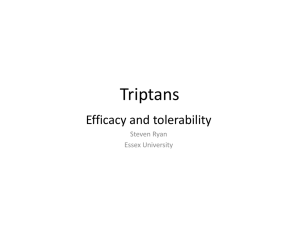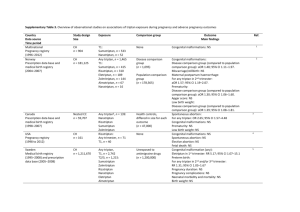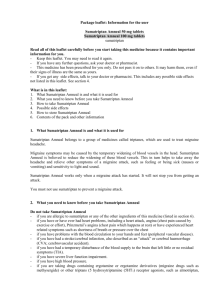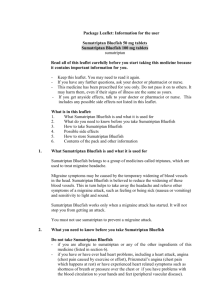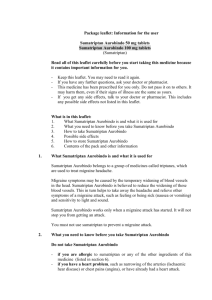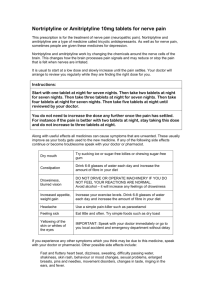Elderly (over 65 years of age)
advertisement
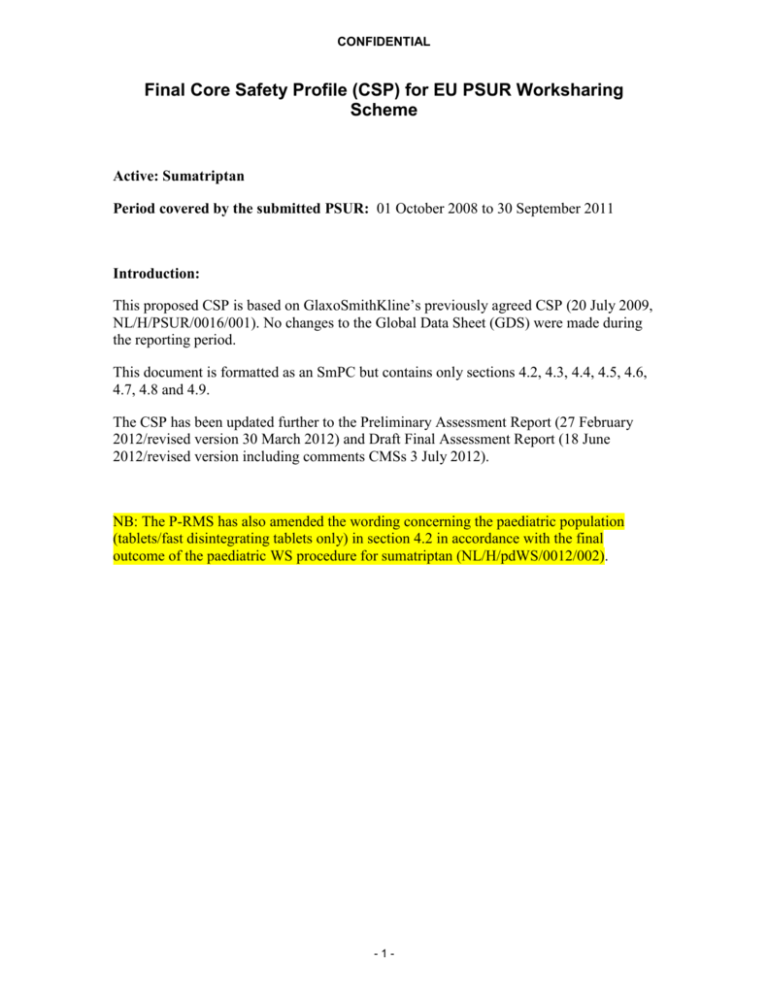
CONFIDENTIAL Final Core Safety Profile (CSP) for EU PSUR Worksharing Scheme Active: Sumatriptan Period covered by the submitted PSUR: 01 October 2008 to 30 September 2011 Introduction: This proposed CSP is based on GlaxoSmithKline’s previously agreed CSP (20 July 2009, NL/H/PSUR/0016/001). No changes to the Global Data Sheet (GDS) were made during the reporting period. This document is formatted as an SmPC but contains only sections 4.2, 4.3, 4.4, 4.5, 4.6, 4.7, 4.8 and 4.9. The CSP has been updated further to the Preliminary Assessment Report (27 February 2012/revised version 30 March 2012) and Draft Final Assessment Report (18 June 2012/revised version including comments CMSs 3 July 2012). NB: The P-RMS has also amended the wording concerning the paediatric population (tablets/fast disintegrating tablets only) in section 4.2 in accordance with the final outcome of the paediatric WS procedure for sumatriptan (NL/H/pdWS/0012/002). -1- CONFIDENTIAL Sumatriptan FInal Core Safety Profile (CSP) 4.2 Posology and method of administration (safety information only) All formulations: Sumatriptan should not be used prophylactically. Tablets, fast disintegrating tablets, nasal spray, suppositories: Sumatriptan is recommended as monotherapy for the acute treatment of a migraine attack and should not be given concomitantly with ergotamine or derivatives of ergotamine (including methysergide) (see section 4.3). It is advisable that sumatriptan be given as early as possible after the onset of a migraine headache. It is equally effective at whatever stage of the attack it is administered. Injection: It is advisable that sumatriptan be given as early as possible after the onset of a migraine headache or associated symptoms such as nausea, vomiting or photophobia. It is equally effective at whatever stage of the attack it is administered. The efficacy of sumatriptan is independent of the duration of the attack when starting treatment. Administration during a migraine aura prior to other symptoms occurring may not prevent the development of a headache. Populations Tablets: • Adults The recommended dose of oral sumatriptan is a single 50 mg tablet. Some patients may require 100 mg. If a patient does not respond to the first dose of sumatriptan, a second dose should not be taken for the same attack. In these cases the attack can be treated with paracetamol, acetylsalicylic acid, or non-steroidal anti-inflammatory drugs. Sumatriptan tablets may be taken for subsequent attacks. If the patient has responded to the first dose, but the symptoms recur a second dose may be given in the next 24 hours, provided that there is a minimum interval of 2 hours between the two doses. No more than 300 mg should be taken in any 24-hour period. The tablets should be swallowed whole with water. -2- CONFIDENTIAL • Paediatric population The efficacy and safety of sumatriptan (film-coated) tablets/dispersible tablets in children aged less than 10 years have not been established. No clinical data are available in this age group. The efficacy and safety of sumatriptan (film-coated) tablets/dispersible tablets in children 10 to 17 years of age have not been demonstrated in the clinical trials performed in this age group. Therefore the use of Sumatriptan (film-coated) tablets/dispersible tablets in children 10 to 17 years of age is not recommended (see section 5.1). • Elderly (over 65 years of age) Experience of the use of sumatriptan tablets in patients aged over 65 years is limited. The pharmacokinetics do not differ significantly from a younger population, but until further clinical data are available, the use of sumatriptan in patients aged over 65 years is not recommended. Fast disintegrating tablets: • Adults The recommended dose of oral sumatriptan fast disintegrating tablet is a single 50 mg tablet. Some patients may require 100 mg. If a patient does not respond to the first dose of sumatriptan, a second dose should not be taken for the same attack. In these cases the attack can be treated with paracetamol, acetylsalicylic acid, or non-steroidal anti-inflammatory drugs. Sumatriptan fast disintegrating tablets may be taken for subsequent attacks. If the patient has responded to the first dose, but the symptoms recur a second dose may be given in the next 24 hours, provided that there is a minimum interval of 2 hours between the two doses. No more than 300 mg should be taken in any 24-hour period. The tablets should be swallowed whole with water. Patients with swallowing difficulties may choose to disperse a tablet in a small amount of water before administration. Sumatriptan fast disintegrating tablets dispersed in water have a bitter taste. • Paediatric population The efficacy and safety of sumatriptan (film-coated) tablets/dispersible tablets in children aged less than 10 years have not been established. No clinical data are available in this age group. The efficacy and safety of sumatriptan (film-coated) tablets/dispersible tablets in children 10 to 17 years of age have not been demonstrated in the clinical trials performed in this age group. Therefore the use of Sumatriptan (film-coated) tablets/dispersible tablets in children 10 to 17 years of age is not recommended (see section 5.1). • Elderly (over 65 years of age) Experience of the use of standard sumatriptan tablets in patients aged over 65 years is limited. The pharmacokinetics do not differ significantly from a younger population, but until further clinical data are available, the use of sumatriptan fast disintegrating tablets in patients aged over 65 years is not recommended. -3- CONFIDENTIAL Injection: Sumatriptan injection should be injected subcutaneously using an autoinjector. Patients should be advised to observe strictly the instruction leaflet for the sumatriptan autoinjector, especially regarding the safe disposal of syringes and needles. • Adults MIGRAINE The recommended dose of sumatriptan injection is a single 6 mg subcutaneous injection. If a patient does not respond to the first dose of sumatriptan, a second dose should not be taken for the same attack. In these cases the attack can be treated with paracetamol, acetylsalicylic acid, or non-steroidal anti-inflammatory drugs. Sumatriptan injection may be taken for subsequent attacks. If the patient has responded to the first dose, but the symptoms recur a second dose may be given in the next 24 hours, provided that there is a minimum interval of 1 hour between the two doses. The maximum dose in 24 hours is two 6 mg injections (12 mg). CLUSTER HEADACHE The recommended dose of sumatriptan injection is a single 6 mg subcutaneous injection for each cluster attack. The maximum dose in 24 hours is two 6 mg injections (12 mg) with a minimum interval of 1 hour between the two doses. • Children and Adolescents (under 18 years of age) Sumatriptan injection is not recommended for use in children and adolescents due to insufficient data on safety and efficacy. • Elderly (over 65 years of age) Experience of the use of sumatriptan in patients aged over 65 years is limited. The pharmacokinetics do not differ significantly from a younger population, but until further clinical data are available, the use of sumatriptan in patients aged over 65 years is not recommended. Nasal spray: Adults (18 years of age and over) The optimal dose of sumatriptan Nasal Spray is 20 mg for administration into one nostril. However, due to inter/intra patient variability of both the migraine attacks and the absorption of sumatriptan, 10 mg may be effective in some patients. If a patient does not respond to the first dose of sumatriptan, a second dose should not be taken for the same attack. In these cases the attack can be treated with paracetamol, acetylsalicylic acid or non-steroidal anti-inflammatory drugs. Sumatriptan may be taken for subsequent attacks. If the patient has responded to the first dose but the symptoms recur, a second dose may be given in the following 24 hours, provided that there is a minimum interval of 2 hours between the two doses. -4- CONFIDENTIAL No more than two doses of sumatriptan 20 mg nasal spray should be taken in any 24-hour period. Adolescents (12–17 years of age) Use of sumatriptan in adolescents should be on the recommendation of a specialist or physician who has significant experience in treating migraine, taking into account local guidance. The recommended dose of sumatriptan nasal spray is 10 mg for administration into one nostril. If a patient does not respond to the first dose of sumatriptan, a second dose should not be taken for the same attack. In these cases the attack can be treated with paracetamol, acetylsalicylic acid or non-steroidal anti-inflammatory drugs. Sumatriptan may be taken for subsequent attacks. If the patient has responded to the first dose but the symptoms recur, a second dose may be given in the following 24 hours, provided that there is a minimum interval of 2 hours between the two doses. No more than two doses of sumatriptan 10 mg nasal spray should be taken in any 24-hour period. Children (under 12 years of age) Sumatriptan nasal spray is not recommended for use in children under 12 years of age due to insufficient data on safety and efficacy. Elderly (over 65) There is no experience of the use of sumatriptan nasal spray in patients over 65. The pharmacokinetics in elderly patients have not been sufficiently studied. Therefore the use of sumatriptan is not recommended until further data are available. Suppositories: • Adults (18 years of age and over) The recommended dose of sumatriptan suppositories for the acute treatment of a migraine attack is one 25 mg suppository administered rectally. If a patient does not respond to the first dose of sumatriptan, a second dose should not be taken for the same attack. In these cases the attack can be treated with paracetamol, acetylsalicylic acid or non-steroidal anti-inflammatory drugs. Sumatriptan may be taken for subsequent attacks. If the patient has responded to the first suppository, but the symptoms recur a second suppository may be used in the next 24 hours, provided that there is a minimum interval of 2 hours between the two suppositories. No more than two sumatriptan 25 mg suppositories should be used in any 24-hour period. • Children and Adolescents (under 18 years of age) Sumatriptan suppositories are not recommended for use in children and adolescents as sumatriptan suppositories have not been studied in these age categories. • Elderly (over 65 years of age) The safety and effectiveness of sumatriptan suppositories in the elderly has not been established. -5- CONFIDENTIAL 4.3 Contraindications All formulations: Hypersensitivity to sumatriptan or to any of the excipients. Sumatriptan should not be given to patients who have had myocardial infarction or have ischaemic heart disease, coronary vasospasm (Prinzmetal’s angina), peripheral vascular disease or symptoms or signs consistent with ischaemic heart disease. Sumatriptan should not be administered to patients with a history of cerebrovascular accident (CVA) or transient ischaemic attack (TIA). Sumatriptan should not be administered to patients with severe hepatic impairment. The use of sumatriptan in patients with moderate and severe hypertension and mild uncontrolled hypertension is contraindicated. The concomitant administration of ergotamine, or derivatives of ergotamine (including methysergide) or any triptan/5-hydroxytryptamine1 (5-HT1) receptor agonist is contraindicated (see section 4.5). Concurrent administration of monoamine oxidase inhibitors (MAOIs) and sumatriptan is contraindicated. Sumatriptan must not be used within 2 weeks of discontinuation of therapy with monoamine oxidase inhibitors. 4.4 Special warnings and precautions for use Tablets, fast disintegrating tablets, nasal spray and suppositories: Sumatriptan should only be used where there is a clear diagnosis of migraine. Injection: Sumatriptan should only be used where there is a clear diagnosis of migraine or cluster headache. Sumatriptan injection should not be given intravenously. All formulations: Sumatriptan is not indicated for use in the management of hemiplegic, basilar or ophthalmoplegic migraine. As with other acute migraine therapies, before treating headaches in patients not previously diagnosed as migraineurs, and in migraineurs who present with atypical symptoms, care should be taken to exclude other potentially serious neurological conditions. It should be noted that migraineurs may be at increased risk of certain cerebrovascular events (e.g. CVA, TIA). Following administration, sumatriptan can be associated with transient symptoms including chest pain and tightness, which may be intense and involve the throat (see section 4.8). Where such -6- CONFIDENTIAL symptoms are thought to indicate ischaemic heart disease, no further doses of sumatriptan should be given and an appropriate evaluation should be carried out. Sumatriptan should be given with caution in patients with mild controlled hypertension, since transient increases in blood pressure and peripheral vascular resistance have been observed in a small proportion of patients (see section 4.3). There have been rare post-marketing reports describing patients with serotonin syndrome (including altered mental status, autonomic instability and neuromuscular abnormalities) following the use of a selective serotonin reuptake inhibitor (SSRI) and sumatriptan. Serotonin syndrome has been reported following concomitant treatment with triptans and serotonin noradrenaline reuptake inhibitors (SNRIs). If concomitant treatment with sumatriptan and an SSRI/SNRI is clinically warranted, appropriate observation of the patient is advised (see section 4.5) Sumatriptan should be administered with caution to patients with conditions that may affect significantly the absorption, metabolism, or excretion of the drug, e.g. impaired hepatic or renal function. Sumatriptan should be used with caution in patients with a history of seizures or other risk factors which lower the seizure threshold, as seizures have been reported in association with sumatriptan (see section 4.8). Patients with known hypersensitivity to sulphonamides may exhibit an allergic reaction following administration of sumatriptan. Reactions may range from cutaneous hypersensitivity to anaphylaxis. Evidence of cross sensitivity is limited, however, caution should be exercised before using sumatriptan in these patients. Undesirable effects may be more common during concomitant use of triptans and herbal preparations containing St John’s Wort (Hypericum perforatum). Prolonged use of any type of painkiller for headaches can make them worse. If this situation is experienced or suspected, medical advice should be obtained and treatment should be discontinued. The diagnosis of medication overuse headache (MOH) should be suspected in patients who have frequent or daily headaches despite (or because of) the regular use of headache medications. The recommended dose of sumatriptan should not be exceeded All formulations: Sumatriptan should not be given to patients with risk factors for ischaemic heart disease, including those patients who are heavy smokers or users of nicotine substitution therapies, without prior cardiovascular evaluation (see section 4.3). Special consideration should be give to postmenopausal women and males over 40 with these risk factors. These evaluations however, may not identify every patient who has cardiac disease and, in very rare cases, serious cardiac events have occurred in patients without underlying cardiovascular disease (Nasal Spray only: and in adolescents (see section 4.8). For tablets only: Patients with rare hereditary problems of galactose intolerance, the Lapp lactase deficiency or glucose-galactose malabsorption should not take this medicine as it contains lactose. -7- CONFIDENTIAL 4.5 Interactions with other medicinal products and other forms of interaction All formulations: There is no evidence of interactions with propranolol, flunarizine, pizotifen or alcohol. There are limited data on an interaction with preparations containing ergotamine or another triptan/5-HT1 receptor agonist. The increased risk of coronary vasospasm is a theoretical possibility and concomitant administration is contraindicated (see section 4.3). The period of time that should elapse between the use of sumatriptan and ergotamine-containing preparations or another triptan/5-HT1 receptor agonist is not known. This will also depend on the doses and types of products used. The effects may be additive. It is advised to wait at least 24 hours following the use of ergotamine-containing preparations or another triptan/5-HT1 receptor agonist before administering sumatriptan. Conversely, it is advised to wait at least 6 hours following use of sumatriptan before administering an ergotamine-containing product and at least 24 hours before administering another triptan/5-HT1 receptor agonist. An interaction may occur between sumatriptan and MAOIs and concomitant administration is contraindicated (see section 4.3). There have been rare post-marketing reports describing patients with serotonin syndrome (including altered mental status, autonomic instability and neuromuscular abnormalities) following the use of SSRIs and sumatriptan. Serotonin syndrome has also been reported following concomitant treatment with triptans and SNRIs (see section 4.4). 4.6 Fertility, Pregnancy and Lactation All formulations Pregnancy Post-marketing data on the use of sumatriptan during the first trimester of pregnancy in over 1,000 women are available. Although these data contain insufficient information to draw definitive conclusions, they do not point to an increased risk of congenital defects. Experience with the use of sumatriptan in the second and third trimester is limited. Evaluation of experimental animal studies does not indicate direct teratogenic effects or harmful effects on peri- and postnatal development. However, embryo-foetal viability might be affected in the rabbit (see section 5.3). Administration of sumatriptan should only be considered if the expected benefit to the mother is greater than any possible risk to the foetus. Lactation It has been demonstrated that following subcutaneous administration sumatriptan is secreted into breast milk. Infant exposure can be minimised by avoiding breast-feeding for 12 hours after treatment, during which time any breast milk expressed should be discarded. 4.7 Effects on ability to drive and use machines -8- CONFIDENTIAL All formulations: No studies on the effects on the ability to drive and use machines have been performed. Drowsiness may occur as a result of migraine or its treatment with sumatriptan. This may influence the ability to drive and to operate machinery. 4.8 Undesirable effects Adverse events are listed below by system organ class and frequency. Frequencies are defined as: very common (≥1/10), common (≥1/100, <1/10), uncommon (≥1/1000, <1/100), rare (≥1/10,000, <1/1000), very rare (<1/10,000), not known (cannot be estimated from the available data). Some of the symptoms reported as undesirable effects may be associated symptoms of migraine. For nasal spray only: Adverse events reported in adults have also been observed in adolescents. These include very rare reports of coronary artery vasospasm and myocardial infarction (See section 4.4). All formulations: Immune system disorders Not known: Hypersensitivity reactions ranging from cutaneous hypersensitivity (such as urticaria) to anaphylaxis. Nervous system disorders Common: Dizziness, drowsiness, sensory disturbance including paraesthesia and hypoaesthesia. Not known: Seizures, although some have occurred in patients with either a history of seizures or concurrent conditions predisposing to seizures. There are also reports in patients where no such predisposing factors are apparent; Tremor, dystonia, nystagmus, scotoma. Eye disorders Not known: Flickering, diplopia, reduced vision. Loss of vision including reports of permanent defects. However, visual disorders may also occur during a migraine attack itself. Cardiac disorders Not known: Bradycardia, tachycardia, palpitations, cardiac arrhythmias, transient ischaemic ECG changes, coronary artery vasospasm, angina, myocardial infarction (see section 4.3 and 4.4). -9- CONFIDENTIAL Vascular disorders Common: Transient increases in blood pressure arising soon after treatment. Flushing. Not known: Hypotension, Raynaud’s phenomenon. Respiratory, thoracic and mediastinal disorders Common: Dyspnoea. Gastrointestinal disorders Common: Nausea and vomiting occurred in some patients but it is unclear if this is related to sumatriptan or the underlying condition. Not known: Ischaemic colitis. Not known: Diarrhoea. Musculoskeletal and connective tissue disorders Common: Sensations of heaviness (usually transient and may be intense and can affect any part of the body including the chest and throat). Myalgia. Not known: Neck stiffness. Not known: Arthralgia. General disorders and administration site conditions Common: Pain, sensations of heat or cold, pressure or tightness (these events are usually transient and may be intense and can affect any part of the body including the chest and throat); feelings of weakness, fatigue (both events are mostly mild to moderate in intensity and transient). Investigations Very rare: Minor disturbances in liver function tests have occasionally been observed. Psychiatric disorders Not known: Anxiety. Skin and subcutaneous tissue disorders Not known: Hyperhidrosis. - 10 - CONFIDENTIAL Nasal spray only: Nervous system disorders Very common: Dysgeusia/unpleasant taste. Respiratory, thoracic and mediastinal disorders Common: Following administration of sumatriptan nasal spray mild, transient irritation or burning sensation in the nose or throat or epistaxis have been reported. Injection only The most common side effects associated with treatment with sumatriptan administered subcutaneously are: General disorders and administration site conditions Very common: Transient injection site pain Very common: Injection site stinging/burning, swelling, erythema, bruising and bleeding have also been reported. Although direct comparisons are not available, flushing, paraesthesia and sensations of heat, pressure, and heaviness may be more common after sumatriptan injection. Conversely, nausea, vomiting and fatigue appear to be less frequent with subcutaneous administration of sumatriptan injection than with tablets. 4.9 Overdose Symptoms and Signs Tablets: Doses in excess of 400 mg orally and 16 mg subcutaneously were not associated with side effects other than those mentioned. Patients have received single injections of up to 12 mg subcutaneously without significant adverse effects. Fast disintegrating tablets: Doses up to 100 mg orally were not associated with side effects other than those mentioned. Injection: There have been some reports of overdosage with sumatriptan injection. - 11 - CONFIDENTIAL Patients have received single injections of up to 12 mg subcutaneously without significant adverse effects. Doses up to 16 mg subcutaneously were not associated with side effects other than those mentioned. Nasal spray: Single doses of sumatriptan up to 40 mg intranasally, in excess of 16 mg subcutaneously and 400 mg orally have not been associated with side effects other than those mentioned. In clinical studies volunteers have received 20 mg of sumatriptan by the intranasal route three times a day for a period of 4 days without significant adverse effects. Suppositories: Single doses up to 200 mg rectally and in excess of 16mg subcutaneously and 400mg orally have not been associated with side effects other than those mentioned. In clinical studies volunteers have received 50 mg of sumatriptan by the rectal route twice a day for a period of 5 days without significant adverse effects. Treatment All formulations: If overdosage occurs, the patient should be monitored for at least 10 hours and standard supportive treatment applied as required. It is unknown what effect haemodialysis or peritoneal dialysis has on the plasma concentrations of sumatriptan. ________________________________________________________________ - 12 -

